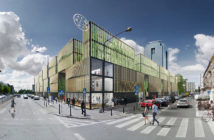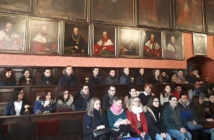![]()
An interview with the vice-rector of the Shrine of Divine Mercy in Kraków, who is also the director of the local Pastoral House.

• Father, thousands of pilgrims visit the Sanctuary of Divine Mercy every day – those who stop for a short time and those who stay longer in the Pastoral House. What are such people from around the world searching for?
• We touch on the deepest questions that both believers and non-believers ask themselves. Each of us, created in the image and likeness of God, has a longing for God. The times in which St. Faustina lived were a period of great anxiety. Within the external dimension we think of the First World War and the struggle for Polish independence. It was also a time when God was being removed from the human conscience. All these dilemmas and concerns were experienced by each and everyone. However, there was also an inner struggle and this was the struggle of the human heart in the fight for good, the attempt to break away from evil, from sin. That is why the Good God, through the ministry of St. Faustina, reminded us that He is merciful, that He comes to help in response to human misery and weakness, that no one is lost to Him and everyone still has a chance to return and restore themselves and their conscience. So visitors come to the Shrine to seek prayer, reflection, silence, a change in their lives. Sociologists studying pilgrims’ movements have formulates an interesting statement: Every pilgrim may be a tourist but also every tourist can become a pilgrim.’ The architectural, situational, and historical aspects can even accidentally guide an individual to prayer, reflection, to God, and help them to transform their lives! These aspects are interlinked in this place. In a nutshell, the words St. John Paul II said here years ago become true: Everyone can come here, look at this image of the merciful Christ, his heart radiant with mercy, and in the depths of his soul hear what the Blessed One heard: ’ Do not be afraid of anything, I am always with you’ (Diary, p. II). And if they sincerely reply: ‘Jesus, I trust in you, ’ they will find solace from all their anxieties and fears.’
• How do you assess the importance of the sanctuary, including the Pastoral House, in the development of the cult of Divine Mercy in recent years?
• On 17th August 2017, we celebrated the 15th anniversary of the consecration of the Basilica of Divine Mercy by St. John Paul II. So much has already happened here. Countless pilgrimages, organized by individual dioceses and parishes, both from our country and from across the world. Congresses of Mercy, symposiums, and conferences on what is understood by mercy. One must not forget the Year of Charity and World Youth Day, when the Sanctuary was visited by young people from 187 countries! And of course, the visits of three popes to this holy place – John Paul II, who consecrated the Sanctuary, Benedict XVI, who met the sick here, and Pope Francis, who was one of the confessors here. The pilgrims benefit from this immense amount of mercy, primarily in the churches, for example, the Chapel of Perpetual Adoration, but also by staying in the Pastoral House for a while, taking advantage of both the accommodation and the food, as well as by attending meetings in the conference room or the John Paul II Aula.
• The sanctuary owes its present form to the initiative of St. John Paul II, a great promoter of the cult of Divine Mercy. Recently, a centre dedicated to the Polish pope called ‘Do not be Afraid’ has been opened next to the Sanctuary. What pastoral significance does this addition have?
• We rejoice in the new project on what we call ‘The White Seas’ because it is a wonderful opportunity for pilgrims who are following in the footsteps of the Apostles of Divine Mercy. This is also possible in reality because the Sanctuary and the Centre of John Paul II have been linked by the Bridge of Mercy for over a year. The message is very spiritual: St. Faustina and St. John Paul II lead to Divine Mercy! Indeed it was John Paul II who discovered St. Faustina. He was looking for support during a time of war and life under totalitarian systems so he went to pray at the monastery chapel of the sisters in Łagiewniki. As a student he worked hard in the clandestine classes held in Solvay (the so-called White Seas) while preparing for the priesthood. This culminated in the canonization of St. Faustina, and the consecration of the Basilica 15 years ago, as well as an expression of the essence of the message and its aims for us in connection with the mystery of Divine Mercy: ‘This spark of Divine Mercy needs to be ignited. We need to convey the fire of mercy to the world. In God’s mercy the world will find peace and man’s happiness.’
![]()
Ogień miłosierdzia
Rozmowa z wicerektorem Sanktuarium Bożego Miłosierdzia w Krakowie i dyrektorem tamtejszego Domu Duszpasterskiego.
• Obserwuje Ksiądz codziennie tysiące pielgrzymów odwiedzających Sanktuarium Miłosierdzia Bożego. I tych, którzy wpadają tam na krótko i takich, którzy zatrzymują się na dłużej w Domu Duszpasterskim. Co ludzie z całego świata tam szukają?
• Dotykamy tutaj najgłębszych pytań, które stawia sobie człowiek zarówno wierzący czy niewierzący. Każdy z nas stworzony na obraz i podobieństwo Boże ma wpisane w serce pragnienie Boga. Czasy św. Faustyny, to okres wielkiego niepokoju. W tym zewnętrznym wymiarze myślimy o I wojnie światowej, o zmaganiach o niepodległość naszego narodu. Czas wyrywania z ludzkich sumień Boga. To wszystko przeżywał pojedynczy człowiek, rozterki, niepokoje. Ale to także wewnętrzne zmagania wówczas jak i zawsze człowieczego serca w walce o dobro, o wyrwanie się od zła, grzechu. Dlatego też Dobry Bóg przez posługę s. Faustyny przypomniał nam, że On jest miłosierny, że nad każdą ludzką nędzą, słabością się pochyla, że nikt nie jest u niego stracony i wciąż ma szanse powrotu i odzyskania pokoju serca i sumienia. Przybywający do Sanktuarium ludzie szukają modlitwy, refleksji, wyciszenia, zmiany o 18o stopni swego życia. Socjologowie badający ruch pielgrzymów formułują takie ciekawe stwierdzenie: ” Każdy pielgrzym może być turystą ale także każdy turysta może stać się pielgrzymem”. Walory architektoniczne, krajobrazowe, historyczne mogą nawet przypadkowego człowieka podprowadzić do modlitwy, refleksji, do Boga i sprawić w nim przemianę życia! Te sfery tego miejsca się przenikają. Jednym słowem wypełniają się słowa św. Jana Pawła II wypowiedziane tutaj przed laty: ” Każdy może tu przyjść, spojrzeć na ten obraz miłosiernego Chrystusa, na Jego Serce promieniujące łaskami, i w głębi duszy usłyszeć to, co słyszała Błogosławiona: „Nie lękaj się niczego, Ja jestem zawsze z Tobą” (Dzienniczek, z. II). A jeśli szczerym sercem odpowie: „Jezu, ufam Tobie! ”, znajdzie ukojenie wszelkich niepokojów i lęków”.
• Jak ocenia Ksiądz znaczenie sanktuarium, w tym Domu Duszpasterskiego dla rozwoju kultu Bożego Miłosierdzia w ostatnich latach?
• 17 sierpnia przeżywaliśmy już 15 rocznicę konsekracji Bazyliki Bożego Miłosierdzia przez św. Jana Pawła II. Tak wiele w tym miejscu się już wydarzyło. Niezliczona liczba pielgrzymek zorganizowanych z kraju, poszczególnych diecezji, parafii i całego świata. Kongresy Miłosierdzia, sympozja, konferencje dotykające tematu szeroko rozumianego miłosierdzia. Trudno nie wspomnieć o szczytowym Roku Miłosierdzia i Światowych Dniach Młodzieży, gdzie Sanktuarium nawiedzili młodzi ludzie ze 187 krajów świata! I oczywiście o nawiedzeniu tego świętego miejsca przez trzech papieży – Jana Pawła II, który świątynię konsekrował, Benedykta XVI, który tutaj spotkał się z chorymi oraz papieża Franciszka, który jako jeden ze spowiedników zasiadł w konfesjonale. Pielgrzymi korzystają z tych przeogromnych pokładów miłosierdzia, korzystając nade wszystko w świątyniach, Kaplicy Wieczystej Adoracji, ale także zatrzymując się na jakiś czas w Domu Duszpasterskim, korzystając zarówno z noclegu, gastronomii, uczestnicząc także w zajęciach w Sali konferencyjnej czy Auli Jana Pawła II.
• Sanktuarium swą obecną postać zawdzięcza inicjatywie św. Jana Pawła II, promotora kultu Bożego Miłosierdzia. Od niedawna niemal tuż obok funkcjonuje poświęcone polskiemu papieżowi centrum „Nie lękajcie”. Jakie znaczenie duszpasterskie ma to sąsiedztwo?
• Radujemy się nowym dziełem na „Białych Morzach”, bo to fantastyczna możliwość dla pielgrzymów, którzy będąc tutaj kroczą śladami Apostołów Bożego Miłosierdzia. A jest to możliwe także fizycznie, gdyż od ponad roku sanktuarium i Centrum Jana Pawła II jest połączone Mostem Miłosierdzia. Bardzo czytelne jest duchowe przesłanie tego miejsca: św. Faustyna i św. Jan Paweł II prowadzą do Bożego Miłosierdzia! To Jan Paweł II odkrył św. Faustynę. Szukał oparcia w czasie zawieruchy wojennej i systemów totalitarnych i już wówczas przychodził na modlitwę do kaplicy klasztornej Sióstr w Łagiewnikach. A na obiektach ówczesnego Solvay (tzw. Białe Morza) jako student ciężko pracował przygotowując się jednocześnie do kapłaństwa na tajnych kompletach. By kiedyś jako papież wynieść do chwały ołtarzy św. Faustynę, 15 lat temu konsekrować bazylikę, by wypowiedzieć istotę przesłania i zadanie dla nas związane z tajemnicą Bożego Miłosierdzia: ”Trzeba tę iskrę łaski Bożej rozniecać. Trzeba przekazywać światu ogień miłosierdzia. W miłosierdziu Boga świat znajdzie pokój a człowiek szczęście”.









